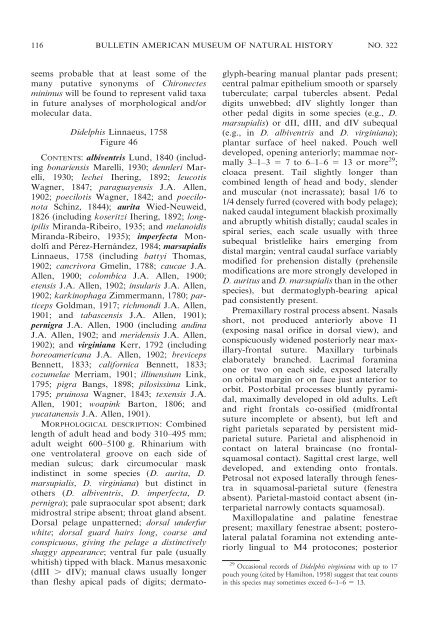phylogenetic relationships and classification of didelphid marsupials ...
phylogenetic relationships and classification of didelphid marsupials ...
phylogenetic relationships and classification of didelphid marsupials ...
Create successful ePaper yourself
Turn your PDF publications into a flip-book with our unique Google optimized e-Paper software.
116 BULLETIN AMERICAN MUSEUM OF NATURAL HISTORY NO. 322<br />
seems probable that at least some <strong>of</strong> the<br />
many putative synonyms <strong>of</strong> Chironectes<br />
minimus will be found to represent valid taxa<br />
in future analyses <strong>of</strong> morphological <strong>and</strong>/or<br />
molecular data.<br />
Didelphis Linnaeus, 1758<br />
Figure 46<br />
CONTENTS: albiventris Lund, 1840 (including<br />
bonariensis Marelli, 1930; dennleri Marelli,<br />
1930; lechei Ihering, 1892; leucotis<br />
Wagner, 1847; paraguayensis J.A. Allen,<br />
1902; poecilotis Wagner, 1842; <strong>and</strong> poecilonota<br />
Schinz, 1844); aurita Wied-Neuweid,<br />
1826 (including koseritzi Ihering, 1892; longipilis<br />
Mir<strong>and</strong>a-Ribeiro, 1935; <strong>and</strong> melanoidis<br />
Mir<strong>and</strong>a-Ribeiro, 1935); imperfecta Mondolfi<br />
<strong>and</strong> Pérez-Hernández, 1984; marsupialis<br />
Linnaeus, 1758 (including battyi Thomas,<br />
1902; cancrivora Gmelin, 1788; caucae J.A.<br />
Allen, 1900; colombica J.A. Allen, 1900;<br />
etensis J.A. Allen, 1902; insularis J.A. Allen,<br />
1902; karkinophaga Zimmermann, 1780; particeps<br />
Goldman, 1917; richmondi J.A. Allen,<br />
1901; <strong>and</strong> tabascensis J.A. Allen, 1901);<br />
pernigra J.A. Allen, 1900 (including <strong>and</strong>ina<br />
J.A. Allen, 1902; <strong>and</strong> meridensis J.A. Allen,<br />
1902); <strong>and</strong> virginiana Kerr, 1792 (including<br />
boreoamericana J.A. Allen, 1902; breviceps<br />
Bennett, 1833; californica Bennett, 1833;<br />
cozumelae Merriam, 1901; illinensium Link,<br />
1795; pigra Bangs, 1898; pilosissima Link,<br />
1795; pruinosa Wagner, 1843; texensis J.A.<br />
Allen, 1901; woapink Barton, 1806; <strong>and</strong><br />
yucatanensis J.A. Allen, 1901).<br />
MORPHOLOGICAL DESCRIPTION: Combined<br />
length <strong>of</strong> adult head <strong>and</strong> body 310–495 mm;<br />
adult weight 600–5100 g. Rhinarium with<br />
one ventrolateral groove on each side <strong>of</strong><br />
median sulcus; dark circumocular mask<br />
indistinct in some species (D. aurita, D.<br />
marsupialis, D. virginiana) but distinct in<br />
others (D. albiventris, D. imperfecta, D.<br />
pernigra); pale supraocular spot absent; dark<br />
midrostral stripe absent; throat gl<strong>and</strong> absent.<br />
Dorsal pelage unpatterned; dorsal underfur<br />
white; dorsal guard hairs long, coarse <strong>and</strong><br />
conspicuous, giving the pelage a distinctively<br />
shaggy appearance; ventral fur pale (usually<br />
whitish) tipped with black. Manus mesaxonic<br />
(dIII . dIV); manual claws usually longer<br />
than fleshy apical pads <strong>of</strong> digits; dermato-<br />
glyph-bearing manual plantar pads present;<br />
central palmar epithelium smooth or sparsely<br />
tuberculate; carpal tubercles absent. Pedal<br />
digits unwebbed; dIV slightly longer than<br />
other pedal digits in some species (e.g., D.<br />
marsupialis) or dII, dIII, <strong>and</strong> dIV subequal<br />
(e.g., in D. albiventris <strong>and</strong> D. virginiana);<br />
plantar surface <strong>of</strong> heel naked. Pouch well<br />
developed, opening anteriorly; mammae normally<br />
3–1–3 5 7 to 6–1–6 5 13 or more 29 ;<br />
cloaca present. Tail slightly longer than<br />
combined length <strong>of</strong> head <strong>and</strong> body, slender<br />
<strong>and</strong> muscular (not incrassate); basal 1/6 to<br />
1/4 densely furred (covered with body pelage);<br />
naked caudal integument blackish proximally<br />
<strong>and</strong> abruptly whitish distally; caudal scales in<br />
spiral series, each scale usually with three<br />
subequal bristlelike hairs emerging from<br />
distal margin; ventral caudal surface variably<br />
modified for prehension distally (prehensile<br />
modifications are more strongly developed in<br />
D. auritus <strong>and</strong> D. marsupialis than in the other<br />
species), but dermatoglyph-bearing apical<br />
pad consistently present.<br />
Premaxillary rostral process absent. Nasals<br />
short, not produced anteriorly above I1<br />
(exposing nasal orifice in dorsal view), <strong>and</strong><br />
conspicuously widened posteriorly near maxillary-frontal<br />
suture. Maxillary turbinals<br />
elaborately branched. Lacrimal foramina<br />
one or two on each side, exposed laterally<br />
on orbital margin or on face just anterior to<br />
orbit. Postorbital processes bluntly pyramidal,<br />
maximally developed in old adults. Left<br />
<strong>and</strong> right frontals co-ossified (midfrontal<br />
suture incomplete or absent), but left <strong>and</strong><br />
right parietals separated by persistent midparietal<br />
suture. Parietal <strong>and</strong> alisphenoid in<br />
contact on lateral braincase (no frontalsquamosal<br />
contact). Sagittal crest large, well<br />
developed, <strong>and</strong> extending onto frontals.<br />
Petrosal not exposed laterally through fenestra<br />
in squamosal-parietal suture (fenestra<br />
absent). Parietal-mastoid contact absent (interparietal<br />
narrowly contacts squamosal).<br />
Maxillopalatine <strong>and</strong> palatine fenestrae<br />
present; maxillary fenestrae absent; posterolateral<br />
palatal foramina not extending anteriorly<br />
lingual to M4 protocones; posterior<br />
29 Occasional records <strong>of</strong> Didelphis virginiana with up to 17<br />
pouch young (cited by Hamilton, 1958) suggest that teat counts<br />
in this species may sometimes exceed 6–1–6 5 13.

















